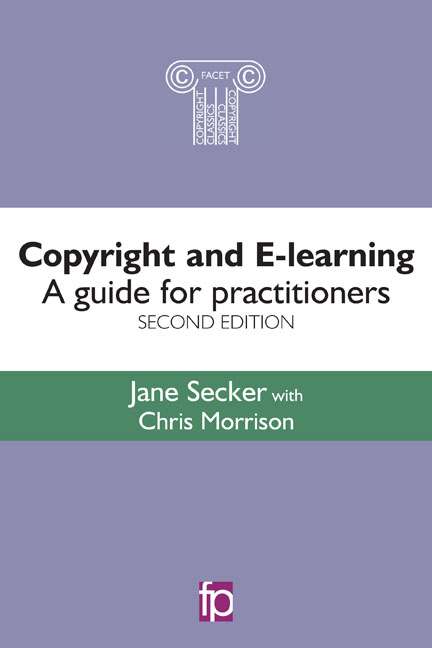Book contents
- Frontmatter
- Contents
- Figures, tables and case studies
- Preface to the second edition
- Introduction
- Abbreviations and acronyms
- Glossary
- 1 E-learning and copyright: background
- 2 Digitizing text-based content for delivery in a VLE
- 3 Using digital media: video, images, sound and software
- 4 Copyright issues and born digital resources
- 5 Copyright in the connected digital environment
- 6 Copyright education and training
- 7 Conclusion
- Further resources
- Index
3 - Using digital media: video, images, sound and software
Published online by Cambridge University Press: 08 June 2018
- Frontmatter
- Contents
- Figures, tables and case studies
- Preface to the second edition
- Introduction
- Abbreviations and acronyms
- Glossary
- 1 E-learning and copyright: background
- 2 Digitizing text-based content for delivery in a VLE
- 3 Using digital media: video, images, sound and software
- 4 Copyright issues and born digital resources
- 5 Copyright in the connected digital environment
- 6 Copyright education and training
- 7 Conclusion
- Further resources
- Index
Summary
Introduction
There is a growing demand for non-text-based digital media content, such as images, video and sound recordings, to provide engaging materials for use in both traditional and online learning. However, copyright questions become increasingly complex when education professionals wish to digitize existing analogue content, as it is usually necessary to obtain permission from several rights holders. Meanwhile, producing digital media content in-house is now technically straightforward but can raise a host of copyright and IPR issues. In both cases delivering this type of content using a VLE highlights, but also exacerbates, the copyright issues. This chapter explores the copyright issues associated with the digitization of non-text-based digital media content, starting with using images in education. It goes on to explore using recordings of broadcast material. In the UK, the ERA licence permits broadcasts to be recorded off-air and digitized for educational use. Although a number of restrictions apply, the ERA licence allows subscribing institutions to deliver free-to-air broadcast content via secure digital networks within the UK. This chapter will also consider digitization of commercially available non-text-based material (including recordings that can be purchased specifically for educational use). Often in these situations permission is required from the rights holder and therefore the procedures for identifying the owner and for securing copyright permission are outlined.
Many educational institutions are now producing digital media content in-house and there are many copyright issues that need to be considered. For example, semi-automated lecture capture systems are now available in many universities in the USA, the UK and other countries (UCISA, 2014). These offer institutions the ability to record and deliver lecture material asynchronously (e.g. after the event for revision purposes) via a computer network. However, copyright issues become a much bigger area of concern when classroom teaching is recorded and made available online. Aside from the need to get permission to include third-party content, the ownership of the resulting video also raises wider IPR concerns in institutions. In some institutions teaching staff have raised concerns over their lectures being recorded and have cited IPR issues (such as their rights as a performer and responsibility for clearing third-party rights) as reasons for objecting. This chapter explores some of these topics, and gives advice for dealing with third-party content and guidance for resolving the ownership of the resulting material.
- Type
- Chapter
- Information
- Copyright and E-learninga guide for practitioners, pp. 87 - 122Publisher: FacetPrint publication year: 2016



